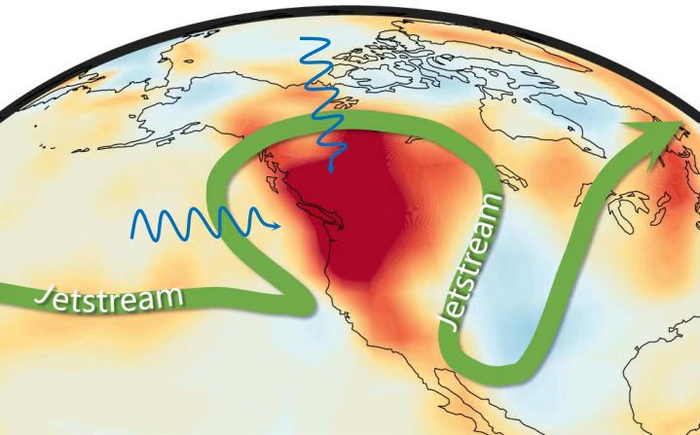The hottest day ever documented in the United Kingdom was July 19th, with temperatures exceeding 40 °C (104 °F). The heatwave is an early insight into what meteorologists predict will be typical summer weather in the United Kingdom in 2050. The heat continues in Europe and the United States, with more than a third of the country under heat alerts.
 Shading represents surface air temperature anomalies, and the green vector denotes jetstream (a narrow band of very strong westerly air currents near the altitude of the tropopause). Two blue vectors indicate that the heatwave is related to anomalous circulations in the North Pacific and the Arctic. Image Credit: Jiayu Zheng
Shading represents surface air temperature anomalies, and the green vector denotes jetstream (a narrow band of very strong westerly air currents near the altitude of the tropopause). Two blue vectors indicate that the heatwave is related to anomalous circulations in the North Pacific and the Arctic. Image Credit: Jiayu Zheng
The temperatures are reminiscent of a late June heat wave that killed nearly 1,500 people and multiplied average temperatures in the United States and Canada just over a year ago.
Will temperatures continue to go up, making extreme heat events more common?
The answer is yes, according to the most recent analysis of the atmospheric circulation patterns and human-caused pollution that contributed to North America’s 2021 heat wave. The research results, published on July 22 in Advances in Atmospheric Sciences, may also discuss the recent heatwave in the United Kingdom.
The research group discovered that greenhouse gases have been the primary cause of rising temperatures in the past and will most likely continue to be the primary contributor in the future, with simulations indicating that extreme heatwave events will rise by more than 30% in the years ahead. According to their findings, greenhouse gases are responsible for the increased likelihood.
An extraordinary and unprecedented heatwave swept western North America in late June of 2021, resulting in hundreds of deaths and a massive die-off of sea creatures off the coast as well as horrific wildfires.
Chunzai Wang, Study Lead Author and Researcher, Southern Marine Science and Engineering Guangdong Laboratory
Wang is also the head of the State Key Laboratory of Tropical Oceanography at the South China Sea Institute of Oceanology, Chinese Academy of Sciences (CAS).
“In this paper, we studied the physical processes of internal variabilities, such as atmospheric circulation patterns, and external forcing, such as anthropogenic greenhouse gases,” Wang added.
Atmospheric circulation patterns define how air flows and impacts surface air temperatures all around the planet, which also can change due to natural warming from the Sun, atmospheric internal variability, and Earth’s rotation.
These setups are responsible for both daily weather and the long-term patterns that make up climate. Using statistical data, the scientists found that three atmospheric circulations co-occurred during the 2021 heatwave: the North Pacific pattern, the Arctic-Pacific Canada pattern, and the North America pattern.
The North Pacific pattern and the Arctic-Pacific Canada pattern co-occurred with the development and mature phases of the heatwave, whereas the North America pattern coincided with the decaying and eastward movements of the heatwave. This suggests the heatwave originated from the North Pacific and the Arctic, while the North America pattern ushered the heatwave out.
Chunzai Wang, Study Lead Author and Researcher, Southern Marine Science and Engineering Guangdong Laboratory
However, atmospheric circulations can co-occur — and have in the past — without causing an extreme heatwave, so how much of the 2021 event was influenced by human activity? Wang and his colleagues used the World Climate Research Program’s internationally compiled, evaluated, and reviewed models, particularly the Detection Attribution Model Comparison models of the Coupled Model Intercomparison Project Phase 6 (CMIP6).
From the CMIP6 models, we found that it is likely that global warming associated with greenhouse gases influences these three atmospheric circulation pattern variabilities, which, in turn, led to a more extreme heatwave event. If appropriate measures are not taken, the occurrence probability of extreme heatwaves will increase and further impact the ecological balance, as well as sustainable social and economic development.
Chunzai Wang, Study Lead Author and Researcher, Southern Marine Science and Engineering Guangdong Laboratory
Co-corresponding author Jiayu Zheng and two students from the University of CAS: Wei Lin and Yuqing Wang also contributed to the study.
Journal Reference:
Wang, C., et al. (2022) Unprecedented Heatwave in Western North America during Late June of 2021: Roles of Atmospheric Circulation and Global Warming. Advances in Atmospheric Sciences. doi.org/10.1007/s00376-022-2078-2.